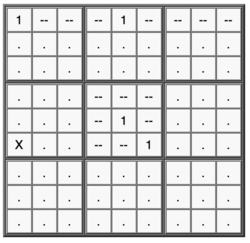Difference between revisions of "Alternating Inference Chain"
From Sudopedia
Jump to navigationJump to search| Line 6: | Line 6: | ||
An example: | An example: | ||
| − | [[Image:alternatinginference.png|250px]] | + | [[Image:alternatinginference.png|250px|left]] |
(1)r1c1=(1)r1c5-(1)r5c5=(1)r6c6 => r6c1<>1 | (1)r1c1=(1)r1c5-(1)r5c5=(1)r6c6 => r6c1<>1 | ||
This chain can be broken down into the following [[implication]]s: | This chain can be broken down into the following [[implication]]s: | ||
Revision as of 01:02, 4 June 2020
An Alternating Inference Chain, better known by its acronym AIC, is a chain of candidates with alternating strong and weak inference.
The vertices in the chain are usually individual candidates, but it is also possible to use groups of candidates or complex patterns like Almost Locked Sets.
It is possible to write AICs with the Eureka notation system.
An example:
(1)r1c1=(1)r1c5-(1)r5c5=(1)r6c6 => r6c1<>1
This chain can be broken down into the following implications:
- If r1c1<>1 then r1c5=1 (strong inference)
- If r1c5=1 then r5c5<>1 (weak inference)
- If r5c5<>1 then r6c6=1 (strong inference)
The chain proves that either r1c1 or r6c6 must contain digit 1. Therefore r6c1 cannot contain digit 1.
When the vertices of an AIC consist of only individual candidates, then it is either a X-Chain, a XY-Chain or some combination of X-Chains and XY-Chains.
